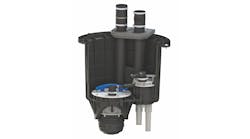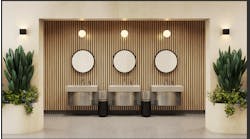BY ROBERT P. MADER
Of CONTRACTOR’s staff
CINCINNATI — This spring the Cincinnati Reds will begin playing in Great American Ballpark, just the third field the team has played on since 1912. The ballpark was designed to create an intimate baseball-watching experience, with 20,000 of it 42,000 seats on field level, compared with 10,000 at Cinergy Field (the old Riverfront Stadium). Designers used other tricks of the trade, such as placing the first seating level 6-in. below the playing surface and reducing the size of foul territory to bring fans closer to the diamond.
Thomas J. Dyer Co., Cincinnati, won the contract to install the plumbing and HVAC systems in the new ballpark. The project was done in two phases, the ballpark itself, and a hall-of-fame facility with a museum, shops and restaurants next to the field. An administration building skirts another flank of the ballpark.
Dyer started connecting to the underground mains in May 2001, said project manager Todd Elliott. Another contractor had performed the underground work before Dyer got on site.
Dyer’s crew connected branches from the 15-in. to 20-in. PVC mains and brought them into the building, boosted by three skid-mounted 50-hp pumps made by Flo-Pak Inc. The domestic water has to serve multiple levels, starting with the service level, mezzanine, terrace level, suite level, club level and view level, which is the upper deck seating area.
All of the domestic water lines are black iron pipe with Victaulic connections. Victaulic connections were also used on copper water pipe down to 2-12-in. Copper 2-in. and smaller was soldered. The largest bathrooms would typically take a 3-in. service line. All of the 4-in. waste lines were Charlotte Pipe & Foundry no-hub.
As is typical in most stadiums, Elliott noted that a fan walking up to the view level concourse, for example, would find the concourse to be nothing but bathrooms and concession stands.
The domestic water supply serves 52 concession stands.
Because the terrace level and view level are the main seating areas, they each include two large bathrooms, men’s and women’s, each with about 100 fixtures. The big bathrooms are supplemented with smaller facilities scattered throughout the concourses.
The plumbers, represented by United Association combined plumbers and pipefitters Local 392, installed American Standard china and faucets and Zurn flush valves. They installed Zurn hospital-style foot pedal faucets in the four nurses stations. There are three of the first aid stations on the terrace level and one on the view level.
All in all, the T.J. Dyer crew installed 507 water closets, 240 urinals, and 509 lavatories.
A combination of central, tank-type and instantaneous water heaters supply hot water, said Plumbing Superintendent Will Hennigan.
The contractor installed three big natural gas PVI water heaters in the boiler room with 1,200-gals of storage each. Bell & Gossett pumps circulate the hot water to the service level, mezzanine and part of the terrace level, Hennigan explained.
The big restrooms on the terrace and view levels have 80-gal. electric storage water heaters in between the men’s room and ladies’ room. Eighty-gallon electric storage heaters serve each concession stand. All of the electrics were supplied by A.O. Smith.
Many of the suites contain a 277V electric instantaneous heater manufactured by Chromite installed beneath the bar sink and serving that sink and the adjacent half bath in each suite. The PVI heaters service some suites on the terrace level.
Kitchens use separate 80-gal. electrics.
The contractor installed 77 showers in the locker rooms, with the shower heads installed at 6ft.2-in. and the controls at 4-ft. One of the showers is ADA accessible, as required by Cincinnati law.
Dyer installed a big hydrotherapy tub in the Reds locker room and they also have three movable stainless steel tubs on wheels. The hydrotherapy tub took a 1-in. cold water feed.
The laundry facility in each locker room takes hot water from the PVI heaters, then runs it through a booster heater to take the temperature to 140°F-145°F.
Because the stadium is built on a flood plain, both the storm drainage and sanitary lines go through ejector pumps.
The storm drainage was particularly challenging, Elliott said, because of access problems and working through and underneath structural steel. Booms and lifts didn’t fit in some places, so Dyer used scaffolding to install some of the storm drainage.
The ejectors pumps will move 12,000 GPM out to the storm sewer system. The sanitary system moves through two dual pumps with 3-in. discharges.
The HVAC system is mostly Trane, starting with two 770-ton R-123 chillers pumping chilled water through 32 large Trane air handlers. The job uses Trane controls too. The biggest of the air handlers moves 37,400 CFM, while the others range from 6,000 to 15,000 CFM. Suites use Trane fan coil units.
The chilled water loop also serves some ice cream machines and large icemakers that didn’t have air-cooled condensers. The “ice making room” on the service level had three such units with bag dispensing mechanisms on them that would bag ice for concessions.
Condenser water is cooled by two Evapco cooling towers, moving 2,740 GPM, which are located on the roof of the adjoining administration building.
The electric panel room is cooled by a computer room style unit manufactured by Data Air and the hydrotherapy room uses a unit with extra dehumidification from Desert Air that’s commonly used in indoor pool applications.
Bell & Gossett pumps move the 45°F chilled water through 6-in. to 8-in. risers to the air handlers and fan coils units. The air moves through constant volume boxes, variable air volume boxes and fan-powered boxes.
There are 3,000 air devices on the job, explained Bill Harmeyer, project manager for sheet metal contractor Cinfab Inc. Cinfab installed 375,000-lbs. of HVAC ductwork and 80,000-lbs. of 16-gauge welded kitchen hoods. There are 95 hoods in the ballpark, Harmeyer said.
The ballpark opened on time this month. Elliott emphasized that the job would not have gone as well as it has without the cooperation and hard work of all of the subcontractors and all of their employees.

